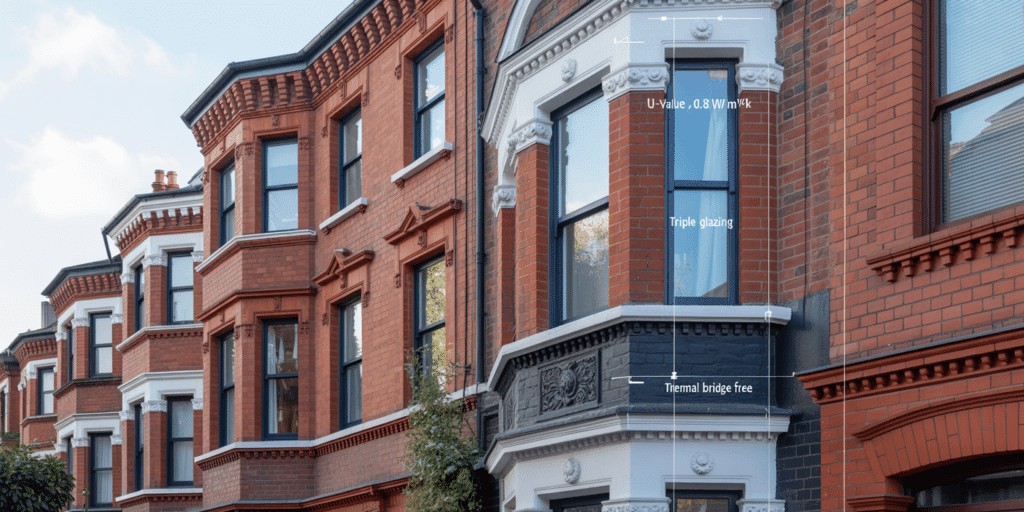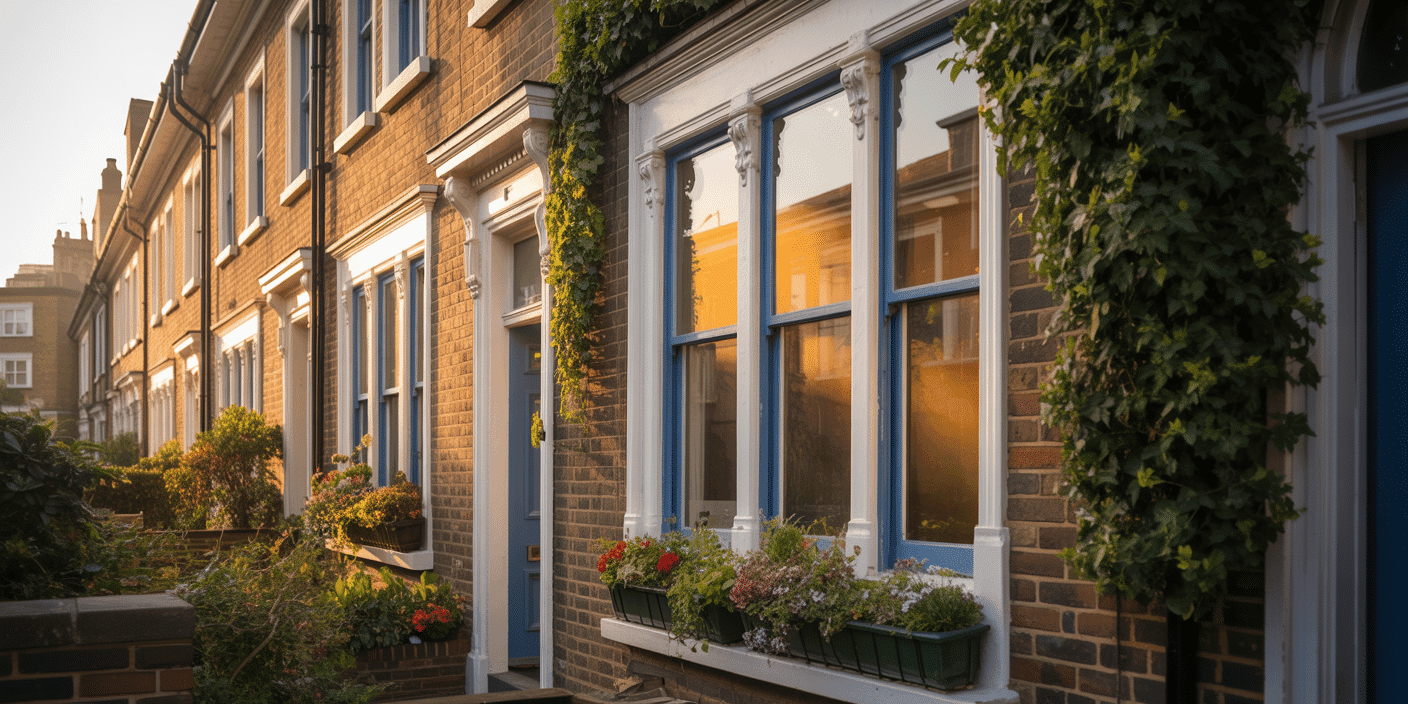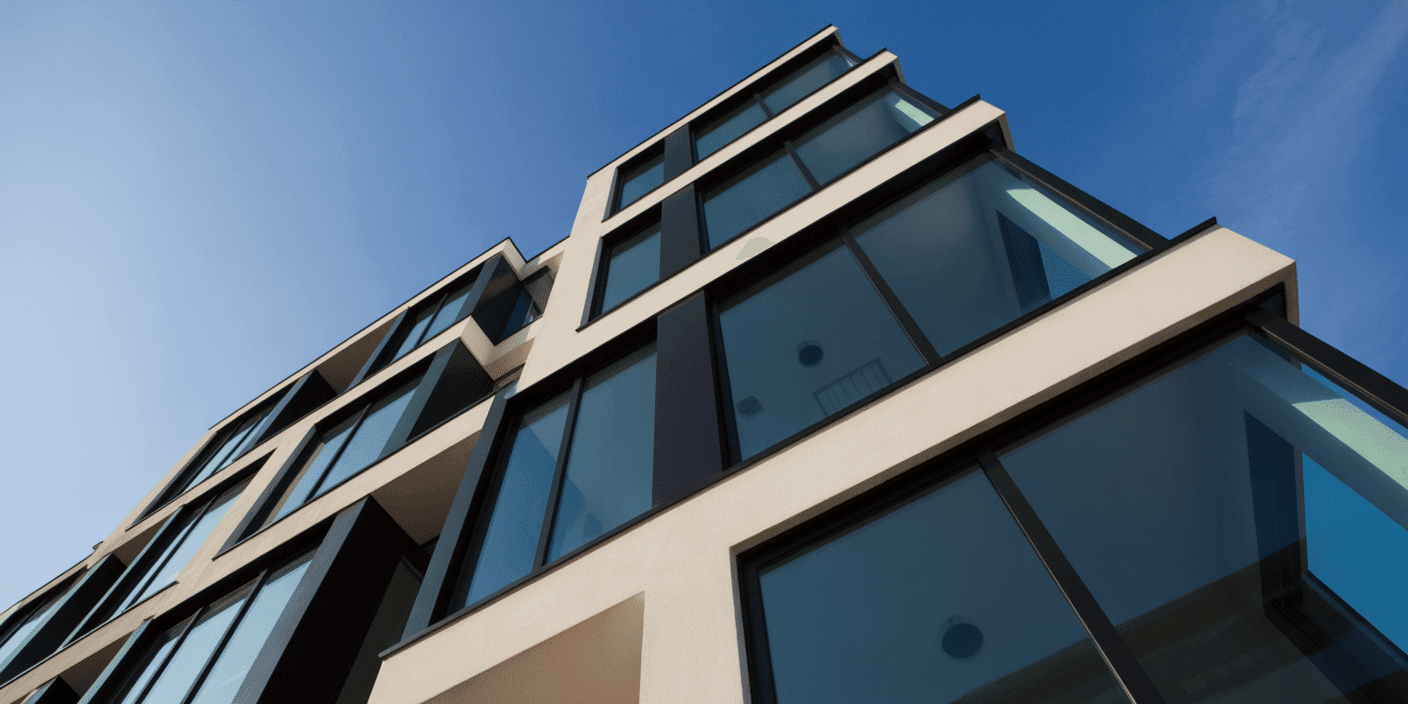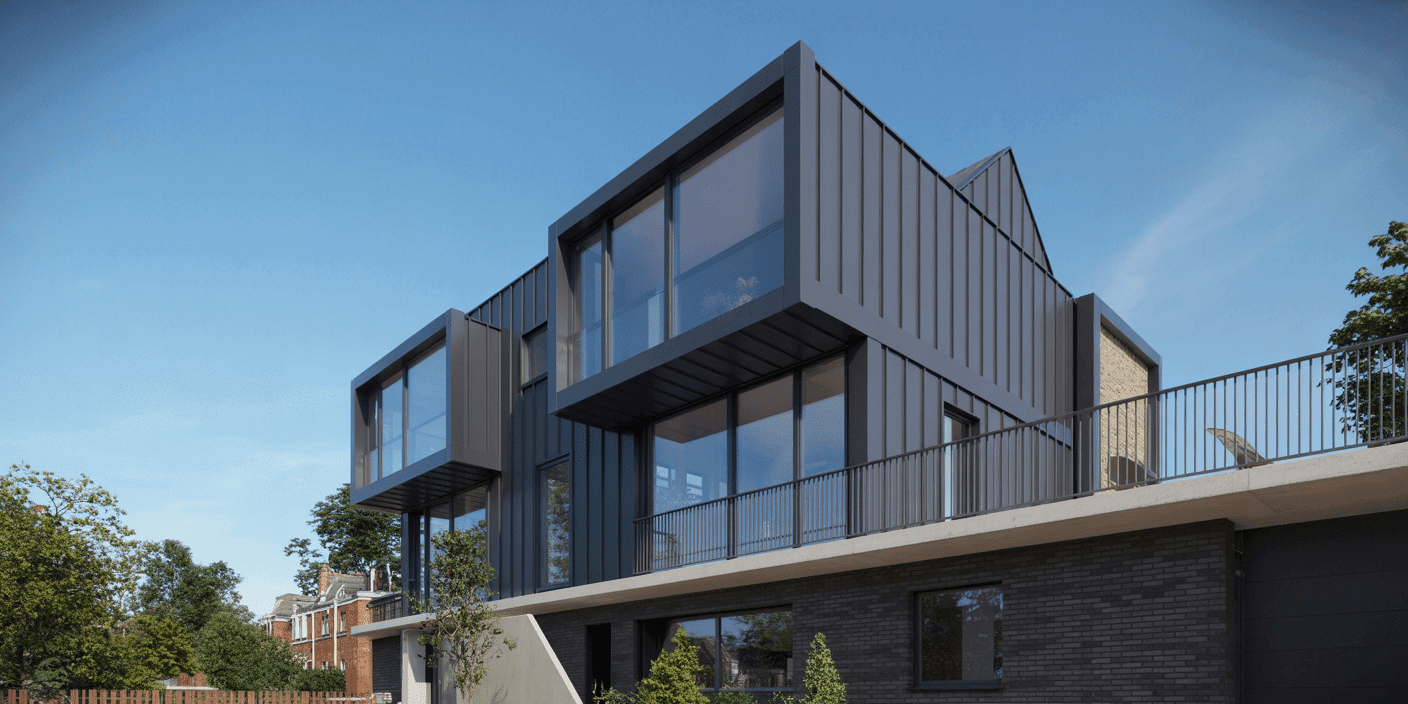The Quiet Revolution in Windows
For over a century, the sash window has defined British architectural heritage — a hallmark of proportion, craftsmanship, and enduring elegance. Yet in a modern context, aesthetic fidelity alone is no longer sufficient.
As the demand for energy efficiency accelerates — driven by rising fuel costs and tightening building regulations — the role of the window is being redefined. What was once a decorative element is now central to a building’s thermal, acoustic, and regulatory performance.
For decades, double glazing represented the industry’s gold standard. Today, it is merely a baseline. The new benchmark is Passivhaus: a precision-engineered, performance-led certification that assesses how effectively a window retains heat, resists draughts, blocks noise, and sustains indoor comfort — with quantifiable rigour.
To the casual observer, a window is glass and timber. To the engineer, it is a system: low-emissivity coatings that reflect infrared radiation; inert gas cavities that slow thermal transfer; frames designed with thermal breaks to eliminate cold bridging. Every element is calibrated for systemic efficiency.
The challenge becomes acute in heritage and conservation settings. How does one meet contemporary energy standards without compromising classical sightlines or diminishing historical detail?
This has catalysed a quiet transformation in British manufacturing. A new generation of heritage-compatible, Passivhaus-certified sash windows now exists — visually indistinguishable from their 19th-century counterparts, yet internally reengineered with triple glazing, thermally insulated frames, and airtight seals capable of meeting today’s most stringent building standards.
There is no spectacle in this evolution. No overt branding, no disruptive aesthetic. Merely quiet, intelligent innovation — delivering windows that preserve the integrity of the past while meeting the demands of the future.
What Passivhaus Really Means (And What It Doesn’t)
“Passivhaus” carries a certain mystique. Some think it means oversized glazing and hyper-modern aesthetics — more Silicon Valley than South Kensington. Others assume it’s only for new builds with budgets fit for Grand Designs. Both are wrong.
Passivhaus isn’t a style. It’s a science.
Born in Germany and backed by decades of research, Passivhaus certification defines how buildings — and by extension, windows — perform. Not how they look.
To meet its strict standards, a window must deliver airtightness, thermal resistance, solar control, and installation integrity as a unified system. Every material, spacer, seal, and join contributes to one goal: minimal energy loss and maximum comfort, year-round.
The Core Technical Requirements
Let’s simplify the jargon. Here’s what a Passivhaus-certified window must achieve:
- U-value of 0.80 W/m²K or lower
This measures heat loss. Lower is better. Most UK windows hover around 1.2–1.6. Passivhaus demands near-zero thermal leakage. - Airtightness: Class 4 (EN 12207)
Meaning: no draughts, no invisible gaps, no acoustic leaks. This isn’t a weather strip; it’s an engineered seal. - Triple glazing (with low-E coating & argon or krypton gas)
Each layer slows down energy transfer. Combined with warm-edge spacers, it stops heat bleeding out — and cold creeping in. - Thermally broken frames
A thermal break is a layer of insulation inside the frame, preventing cold bridging. It’s the unseen line between a comfortable room and a chilly window seat. - Warm installation detailing
Passivhaus isn’t just what you install — it’s how you install it. Reveals, sill tape, perimeter insulation: these matter.
Importantly, you don’t need a futuristic home to use Passivhaus-certified windows. Today, it’s possible to achieve these standards in period properties, conservation areas, and listed buildings — provided your supplier understands the balance of aesthetics and performance.
That’s where the silent specialists shine. They don’t just meet the standard.
They build it into sash horns, lamb’s tongue profiles, and slimline sightlines — all while achieving thermal metrics that most modern casements fail to reach.
Because true heritage isn’t about staying stuck in time.
It’s about moving forward, discreetly — without losing what matters.
The Anatomy of a Passivhaus-Certified Window

In the world of Passivhaus, performance isn’t a marketing word — it’s a measurable, tested outcome. To get there, every window component must earn its place.
A common misconception is that it’s the glass that does all the work. In truth, it’s the harmony between glazing, frame, seals, and installation that creates a high-performance system. Miss one, and the entire window underperforms. Think of it like an orchestra — a single off-note ruins the whole movement.
Let’s open it up, layer by layer.
1. Triple Glazing: More Than Just an Extra Pane
Yes, Passivhaus windows use triple glazing. But it’s not simply “more glass” — it’s precision-layered glass.
Each pane has:
- Low-emissivity (Low-E) coatings to reflect radiant heat inward
- Gas-filled cavities (usually argon or krypton) are used to slow thermal transmission
- Warm-edge spacers that separate panes and reduce cold bridging at the edge
This structure ensures heat stays in during winter, and excessive solar gain is reduced in summer — critical for year-round comfort without over-reliance on mechanical systems.
2. Thermally Broken Frames: The Invisible Shield
In most windows, the frame is the thermal weak point. It conducts heat like a radiator — straight out of the building envelope.
Passivhaus-grade windows are different. They use timber or alu-clad frames engineered with a thermal break: a layer of insulation built into the core. This isolates the warm interior from the cold exterior, preventing both energy loss and internal condensation.
Timber is naturally insulative. When combined with composite technology — as seen in alu-clad timber systems — it delivers strength, durability, and aesthetics with no compromise on performance.
3. Airtight Seals: Not a Draught Strip. A Defence System.
Passivhaus demands Class 4 airtightness. This isn’t achieved by a single gasket — it requires multi-chambered seals, compression systems, and meticulous frame alignment.
A properly sealed window:
- Eliminates air infiltration (draughts)
- Enhances acoustic isolation
- Prevents dust, pollen, and pollutants from entering through microgaps
- Improves real-world U-value performance by eliminating “thermal bypass”
In short, it keeps the outside out — completely.
4. Precision Installation: Where Performance is Won or Lost
Even the best window fails if installed like an afterthought. Thermal bridging, air leakage, and moisture ingress all occur at the join between window and wall.
That’s why Passivhaus-certified windows must be installed using:
- Sill insulation boards (to prevent cold transfer below the frame)
- Airtight tapes and membranes (to seal reveals without compromise)
- Warm-edge installation reveals (that blend into the building envelope)
This isn’t optional — it’s essential. A weak install nullifies a perfect window. That’s why specialist crews trained in Passivhaus detailing are non-negotiable.
The Window as a System, Not a Spec Sheet
Here’s the truth: no single part of a window makes it Passivhaus. Not the glass. Not the frame. Not even the triple glazing.
It’s the coordinated performance of every component, underpinned by installation integrity, that delivers the result.
In heritage homes, this demands even more precision — slimline frames, deep reveals, traditional joinery. Every detail must serve both beauty and performance.
And when it does? The result is a window that passes the world’s most stringent certification, without betraying the aesthetic of the building it serves.
The Heritage Tension: Beauty vs. Performance
Walk down any street in Chelsea, Bath, or Hampstead and you’ll find sash windows that haven’t changed in 150 years — tall, slim, elegant, and unmistakably British. They’re not just windows. They’re architectural DNA.
But behind their charm lies a problem: they leak heat, invite draughts, and barely register on today’s thermal performance scale.
Upgrading them? That’s no simple matter.
For period and heritage homeowners, it often feels like a trade-off:
Comfort or character. Modern efficiency or traditional authenticity.
Worse still, planning departments and conservation officers are rightly protective. They uphold the visual integrity of listed buildings and conservation areas — rejecting any product that alters sightlines, glazing patterns, or joinery profiles.
❌ Why Most “Solutions” Fail
Most manufacturers take a binary approach:
- Option A: Modern performance windows — bulky, plastic, alien to the façade
- Option B: Replica heritage windows — beautiful, but functionally outdated
Neither satisfy both the planning committee and the comfort-seeking homeowner.
Even some triple-glazed “heritage” windows fail the aesthetic test, with wide glazing bars, clunky horns, or plastic finishes that betray the building’s original character.
And when they’re fitted? The frames often breach thermal continuity. The seals fall short of airtightness. The installer foams the reveal and calls it done.
It’s performance theatre — not real-world excellence.
✅ The Art of Discreet Performance
This is where a new breed of solution steps in — one that refuses to compromise.
Modern Passivhaus-certified sash windows now exist that:
- Match historic sightlines and timber profiles
- Use slimline triple glazing (without increasing sash depth)
- Achieve U-values as low as 0.80 W/m²K
- Deliver Class 4 airtightness, even in box sash configurations
- Pass Part L, Q and K, without sacrificing conservation approval
How is it done? Through deep joinery expertise, paired with engineering precision. Every curve, chamfer, and detail is mapped to the original — while the internal construction meets 21st-century standards.
You don’t notice the performance. You feel it.
When Craftsmanship Meets Compliance
In conservation, it’s often said: “Respect the past. Build for the future.”
Heritage-grade Passivhaus windows do exactly that. They don’t demand sacrifice. They deliver both:
- A window that looks like it belongs in 1860
- And performs like it was designed in 2030
Sash Windows London has quietly led this frontier. No fanfare, no gimmicks — just engineered heritage windows that solve the unsolvable: how to keep your home warm, silent and compliant — without changing how it looks.
How Regulations Frame the Future: Part L, Part Q, and Beyond
When compliance isn’t optional, and performance becomes protection.
For many homeowners, building regulations seem like bureaucratic red tape. But in today’s climate—both literal and legislative—they’re a line of defence: against heat loss, against poor workmanship, and increasingly, against devaluation.
When it comes to windows, three key pieces of UK regulation define what’s acceptable: Part L, Part Q, and Part K. They’re not just technical checklists — they shape what kind of window you’re allowed to install, where, and how.
Ignore them, and you risk not only failed inspections — but invalidated warranties, planning rejections, and expensive reworks.
Part L: Thermal Performance
“Conservation of fuel and power.”
That’s the official name. But what it really means is: stop wasting energy through the glass and frame.
From June 2022, all replacement windows in England must meet a U-value of 1.2 W/m²K or better. For new builds, the standard is even stricter.
But here’s the twist: U-values apply to the whole window unit — not just the glazing.
So even if you’ve got triple glazing, a thermally inefficient frame or poor installation could drag your rating below the legal limit.
Passivhaus-certified windows, by contrast, don’t just meet Part L — they outperform it by 30%–50%, often achieving U-values as low as 0.80 W/m²K.
That’s future-proofing your home — and your heating bills.
Part Q: Security Standards
Security isn’t just about strong locks — it’s now a legal requirement for new homes and certain alterations.
Part Q mandates that windows on ground floors and easily accessible locations must:
- Resist physical attack
- Use PAS 24-rated locking systems
- Prevent levering or glazing removal from outside
In many heritage or replica-style windows, compliance is an afterthought. But a properly designed composite or timber sash system can integrate modern multi-point security without disrupting the visual authenticity.
It’s not visible. But it is essential.
Part K: Safety Glass and Impact Zones
For windows near floors or within 800mm of ground level, Part K requires toughened or laminated safety glass that can withstand impact.
It’s especially important for French doors, large sashes, and bay windows.
When dealing with large-format triple glazing (as often seen in Passivhaus systems), correct glass specification is critical — not just for strength, but for compliance.
Why Regulations Are a Moving Target
Today’s standards are already stringent. But the Future Homes Standard (FHS) is looming — and with it, net-zero-ready performance expectations for all new builds and major retrofits.
If you install windows that barely scrape past today’s threshold, you may find yourself non-compliant in five years or unable to resell without costly upgrades.
Choosing windows that exceed regulations today isn’t just responsible — it’s strategic.
Performance is No Longer Optional. It’s a Shield.
At Sash Windows London, compliance is built into the product. Not bolted on. Every window is engineered to satisfy Part L, Part Q, and Part K — by default, not by exception.
For architects, it’s one less headache.
For homeowners, it’s one more assurance.
For the home? It’s a window that ticks every box the law can throw at it — and every one it can’t.
Not All Installers Are Equal (And That’s Where Performance Dies)

The hidden truth behind failed performance: it’s rarely the window — it’s the way it’s installed.
You can spend thousands on a Passivhaus-certified window. Triple-glazed, thermally broken, airtight to Class 4. But if it’s installed with expanding foam and hope?
You’ve just paid for a Ferrari and handed the keys to someone who rides a bicycle.
The majority of window performance failures happen not in the factory, but on-site.
Not because of the product — but because of the people fitting it.
The Weakest Link: The Installation Gap
Windows aren’t just objects. They’re part of a larger system — a sealed building envelope that must control air movement, moisture ingress, and thermal continuity.
The moment you interrupt that system — with the wrong tape, poor sealing, or a misaligned reveal — you open the door (literally) to:
- Cold bridging
- Draughts
- Condensation
- Noise leakage
- Regulatory non-compliance
And yet, most installations are handled like kitchen cupboards. A bit of foam. A silicone bead. Done.
Not even close.
What Proper Installation Actually Looks Like
Here’s what separates compliant, high-performance installations from the usual suspects:
✅ Sill Insulation and Thermal Breaks
Instead of laying a frame directly onto brick or concrete (massive heat conductors), trained teams install sill insulation boards — preserving the thermal break from window to wall.
✅ Warm Edge Tapes and Membranes
No expanding foam. No gaps. Instead: airtight membranes and pressure-sensitive tapes, pre-compressed to maintain long-term elasticity and performance.
These create a three-layer seal:
- Interior (airtight)
- Centre (insulation)
- Exterior (weatherproof)
✅ Correct Fixings, Levelling, and Load Distribution
A Passivhaus window weighs more than a standard unit. It demands proper structural anchoring, level reveals, and load-spreading across the frame.
One missed step, and your sash leans — causing strain, air gaps, and early failure.
How to Spot a Faulty Install
You might not notice straight away. But over time:
- Your room feels colder near the windows
- You hear wind, despite them being “closed tight”
- The sash doesn’t glide — it sticks, scrapes, or rattles
- Your energy bills don’t drop as expected
In short: your investment isn’t working.
Only thermal imaging, blower door testing, or visual inspection by trained specialists can confirm airtightness and thermal integrity. Anything less is guesswork.
Why Specialist Installers Aren’t Optional — They’re Mandatory
At Sash Windows London, installation isn’t an afterthought. It’s an engineered operation. Every member of our fitting teams is trained in Passivhaus-compliant detailing, with precision systems designed to match each window’s specification.
You’re not buying a window. You’re buying its installed performance.
And when that performance is tested — by building control, or by winter — it won’t just pass.
It will prove itself. Silently. Efficiently. Elegantly.
Performance You Can Feel (and Prove)
Passivhaus isn’t about specs on a sheet. It’s about what you feel, hear, and save — every day.
When you invest in a Passivhaus-grade window, the most profound differences are often the ones you can’t see. They’re not in the marketing claims. They’re in the lived experience — the way a room holds warmth on a freezing morning, or how silence reigns in a house that faces a busy road.
These aren’t promises. They’re proofs — subtle but undeniable.
Comfort You Notice (By Not Noticing Anything)
There’s no drama in a well-insulated room. No cold feet on oak flooring. No draught sneaking through the corners of the frame.
Instead, you get:
- Even internal temperatures — no hot/cold spots near windows
- Elimination of cold zones that pull down the room temperature
- No condensation — even on the coldest days
The comfort is quietly consistent. You don’t need to adjust. You don’t even think about it.
That’s the beauty of passive performance: when it’s working, you forget it’s there.
Silence That Shouldn’t Be Possible
Sash windows have a reputation for rattling. And traditional single or double glazing? Barely any barrier to outside noise.
But with Passivhaus windows, something remarkable happens:
- Triple glazing with laminated panes filters out airborne sound
- Class 4 airtight seals block flanking noise and acoustic leaks
- Solid timber or composite frames dampen resonance
The result? A window that reduces noise levels by up to 38–42 dB — often cutting street or aircraft noise by more than half.
This isn’t marketing speak. It’s something you feel in your nervous system. Your home becomes a sanctuary — not just warmer, but quieter than you thought possible.
Savings That Aren’t Just Claimed — They’re Calculated
Passivhaus isn’t a badge. It’s a quantified standard.
With windows rated at U-values of 0.80 W/m²K or lower, your heat loss is drastically reduced — often by 40–60% compared to legacy sash systems.
For a 4-bedroom period home, that translates to:
- £300–£600 annual energy savings
- Enhanced SAP ratings and EPC scores
- Higher resale value due to energy efficiency credentials
Add in maintenance savings (no warping, no sticking, no sealing every few winters) and the real cost of ownership is dramatically lower over time.
When You Want Proof — Not Promises
For those who like data, the evidence is clear.
We conduct:
- Thermal imaging — showing before-and-after heat retention
- Blower door testing — to verify airtightness performance
- Post-install reports — documenting compliance with Part L, Q, and K
For those who don’t want to read the numbers?
You’ll feel the difference within the first 48 hours. Not in temperature alone — but in how your home behaves. Quieter. More stable. More luxurious.
A Real-World Example: Kensington Townhouse
A 19th-century terraced home in Kensington underwent full sash replacement using heritage Passivhaus windows:
- Sashes retained their original profiles and horn detailing
- Triple glazing fitted with slimline sightlines — no planning rejections
- Airtight Class 4 seals and thermally broken timber frames
- Post-install blower door test showed a 40% improvement in air retention
- Annual savings: £512 on heating, EPC improvement from D to B
The owners didn’t just love the comfort — they loved the silence.
Even with black cabs rumbling past, the drawing room became a reading sanctuary.
Ready for the Standard That Future-Proofs Your Home?
When beauty, compliance and thermal performance stop being a compromise — and become one quiet, confident decision.
For decades, homeowners were asked to choose between tradition and performance. To sacrifice aesthetics for airtightness. Or settle for comfort while hoping the planners wouldn’t notice the glazing bars.
But not anymore.
Passivhaus-certified sash and heritage windows change the equation entirely.
They give you:
- Silent warmth in winter
- Elegance the conservation officer signs off
- Compliance with the regulations no one sees coming
- And a home that looks like 1850 — but performs like 2050.
You don’t have to settle. You don’t have to argue with planners. You don’t even have to explain.
You just have to fit the right window — once.
Why Now?
Because energy prices don’t drop. Regulations don’t soften. Buyers don’t ignore EPCs anymore.
And the best time to get it right? Before the wrong window is installed.
What We Offer Next
At Sash Windows London, we don’t sell windows.
We offer:
- A free performance + planning assessment for your property
- The Planning Pack™: includes sightline diagrams, U-values, and regulatory compliance docs
- Optional thermography + SAP evaluation
- Fully managed installations — discreet, accredited, and conservation-friendly
It’s not about sales. It’s about certainty.
A quiet, efficient, approved solution — from people who’ve done this a hundred times before.
Your Home Deserves Its Future — Without Losing Its Past
You’ve protected your home’s soul for decades.
Let us help you protect its comfort, value, and compliance, too.
Request your Planning Pack today — and join the homes that are already living in the future. Quietly.







